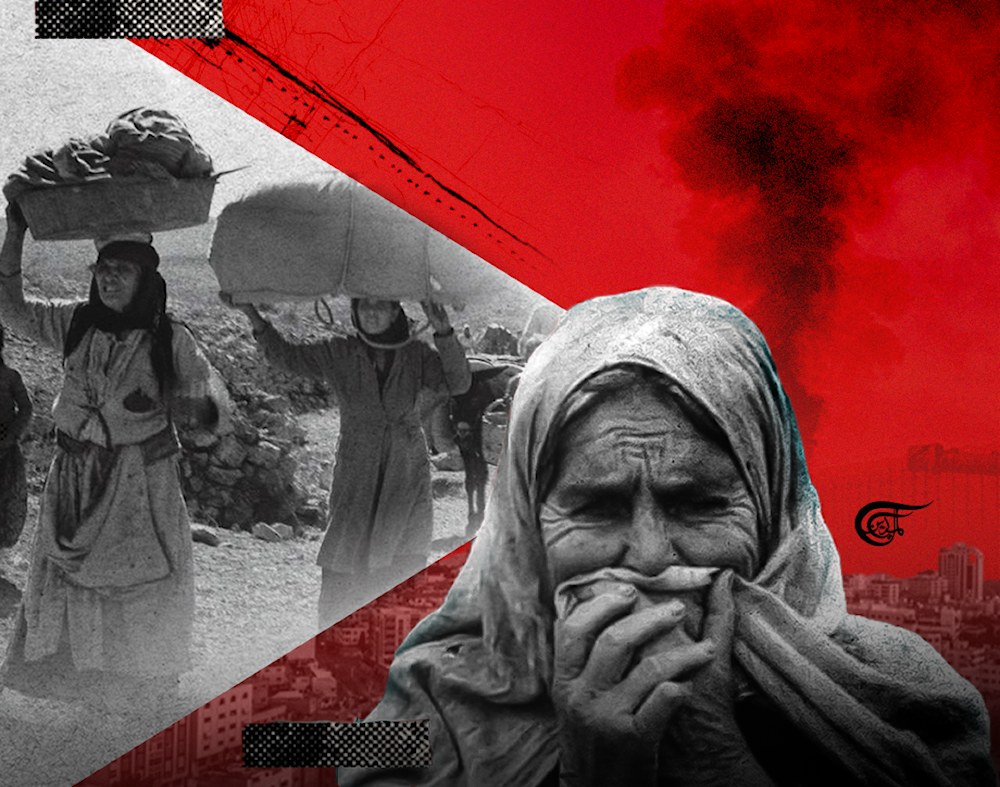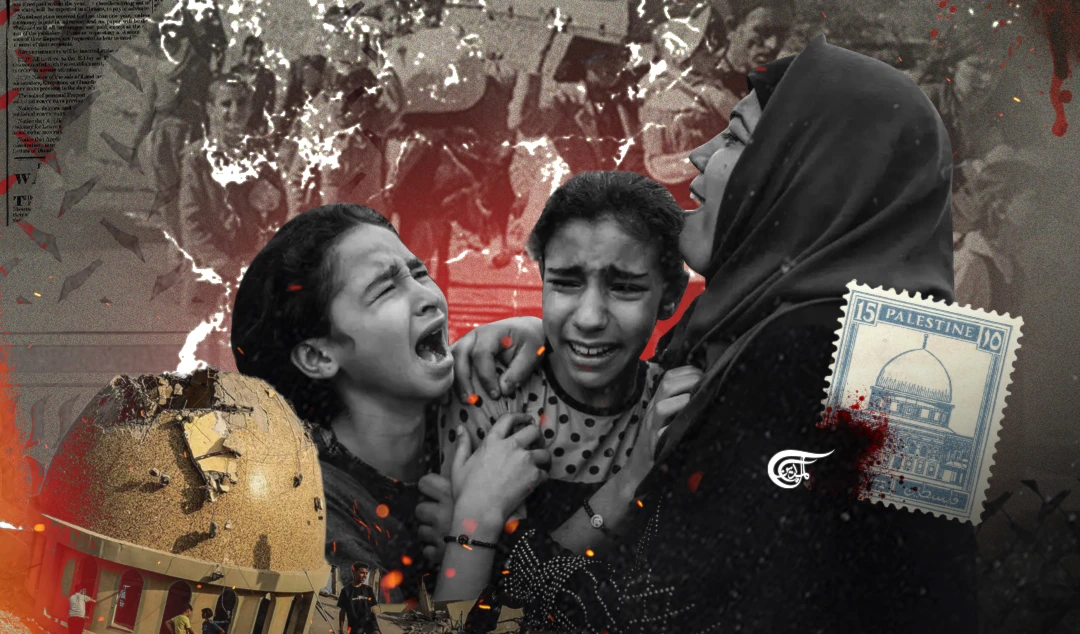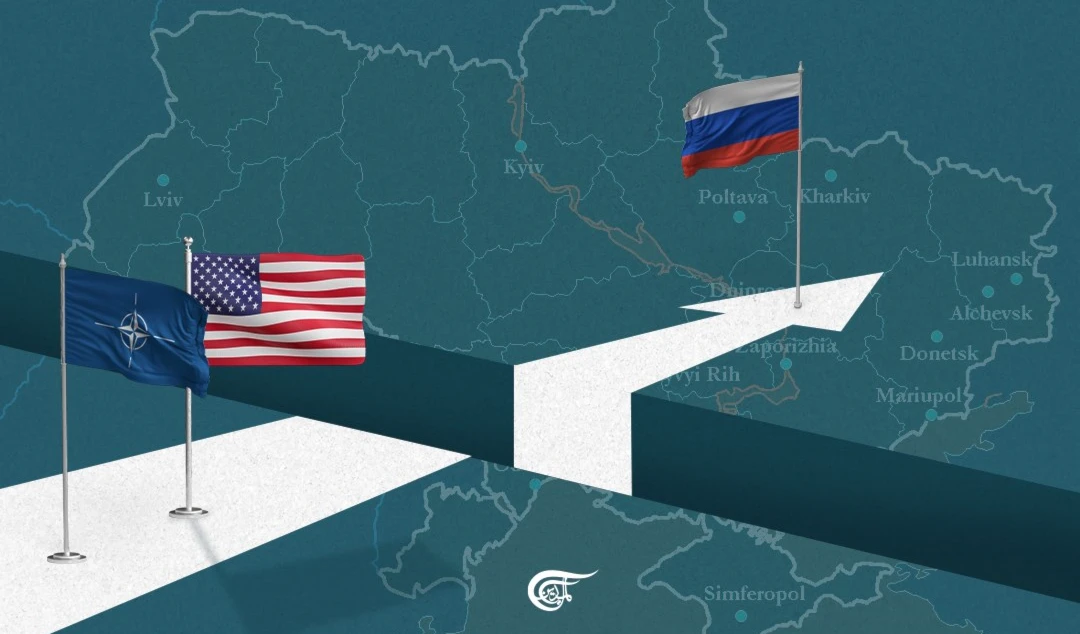Zionism: Genocidal from the beginning
The destruction and atrocities we are seeing in Gaza now are especially horrifying only because they are worse than anything we have seen before.
-

Zionism: Genocidal from the beginning (illustrated by: Batoul Chamas, Al Mayadeen English)
In Palestine, the descendants of the victims of genocide are now accused of genocide. Whether the accusation is upheld by the International Court of Justice remains to be seen, but what we can see, live-streamed around the world every day, are the horrifying consequences of what the regime in Tel Aviv is doing.
Gaza is “uninhabitable,” says Martin Griffiths, the head of the UN Office for the Coordination of Humanitarian Affairs (OCHA); Gaza is “gone,” says Doctors Without Borders. Hundreds of thousands of Gazans have been hounded into the south, near the Egyptian border. Nearly 23,000 had been killed in missile and land attacks by the first week of January 2024, including more than 8,000 children. At least 100 are killed every day, with thousands of others entombed under rubble, which can only be removed by hand because there is no fuel for machines.
There is no anesthetic for the hospitals, as most of the hospitals have been bombed, some repeatedly. Most of the hospitals are now completely closed down or closed to new patients. Wounded children are being treated on blood-smeared floors because there are no more beds. The dead are buried within hospital compounds because anywhere and anyone can be the target of missile strikes.
As for the living Gazans, they are squatting in tents, with no heating and little food. Essential water, health, and sanitation systems have been deliberately damaged or destroyed and diseases are spreading. UNICEF says that in one week from December 17, cases of diarrhea among children were up 50 percent; 90 percent under the age of two were suffering from “severe food poverty.” The health of more than 155,000 pregnant/breastfeeding women is similarly threatened.
By early January 2024, 70 percent of housing in Gaza – 300,000 out of 439,000 dwellings – had been destroyed, with more destroyed in missile strikes every day. The destruction also included hospitals, shopping malls, bakeries, churches, mosques, and more than 200 heritage and archaeological sites. Almost all buildings, that have not been completely flattened, have been too badly damaged to be repaired.
In the West Bank, hundreds of Palestinians have been killed since October 7 by soldiers and settlers and drone attacks on refugee camps. Thousands have been abducted by occupation forces. Many are being held in ‘administrative detention.’ Their treatment is a replay of the humiliation heaped on Palestinian men in Gaza.
According to OCHA, the occupation forces have videotaped and photographed themselves "abusing, degrading and humiliating Palestinians,” by stripping the men naked or half-naked, blindfolding and cuffing them, and physically abusing them, leaving them screaming in pain. They have also been humiliated by being forced to pose with the Zionist flag, sing songs in Hebrew, and dance with soldiers.
The eradication of Gazans is not accidental but deliberate; the end product, up to this point, with possibly more ahead, of a process beginning in the late 19th century with Theodor Herzl’s solution to the problem of establishing a Jewish state in a land already populated by someone else. He wrote of its “penniless population” being “spirited out” beyond Palestine’s borders, at the blow of a whistle, as he put it. The “land without a people for a people without land,” the Zionist slogan, was a lie, at best a self-deserving delusion. Herzl knew the Arabs were there and so did the leaders of the Zionist movement who followed him.
The problem was not how to live with the Palestinians but how to get rid of them. The Zionist leaders came to Palestine intending to rid the land of the indigenous people, not to live with them but instead, of them; not to share but to take and ultimately to steal. Only in the privacy of their diaries or letters did they reveal their true intentions.
Joseph Weitz, the head of the land and afforestation office of the Jewish National Fund (JNF), wrote in his diary: “It must be clear that there is no room in this country for both peoples… there is no other way but to transfer the Arabs from here to neighboring countries, to transfer all of them. Not one village must be left, not one tribe.” David Ben-Gurion, the former prime minister, regarded partition only as a first step towards the establishment of a Jewish state over all of Palestine. Where there was resistance, for example in the Naqab (Negev), “We must expel the Arabs and take their place.” In February 1948, he wrote “The war will give us land. The concept of ‘ours’ and ‘not ours’ are peace concepts only, in war, they lose their whole meaning.”
The Zionist leadership knew the Arabs would resist and began paramilitary preparations early with the establishment of the Watchtower movement to protect their colonies.
In the 1930s, resistance was aimed at Britain, which had handed Palestine to the Zionists and was regarded by the Palestinians as the primary enemy. British garrisons were reinforced and the Palestinian uprising of 1936-39 was crushed through military force, collective punishment, and the execution of ‘rebels.’ About 6,000 Palestinians, including Sheikh Izz al-Din al Qassam and many others who would have led the Palestinians in 1948, were killed.
Still numerically weak, the Zionists declared the doctrine of havlagah (restraint), but by the late 1930s, they were rolling barrel bombs into Palestinian markets and killing dozens of people.
Increasingly, with a European war on the horizon and Britain backing away from some of its more extreme pro-Zionist policies, British police stations and soldiers as well as the indigenous population became the targets of Zionist militias.
In 1944, Lord Moyne, British minister of state for the Middle East, was assassinated in Cairo by agents of the Lehi movement, later the Stern gang, a collaborator with the Irgun in the Deir Yassin massacre of Palestinians (one of many) in 1948. Moyne was Churchill’s friend and Churchill was shocked at the “ingratitude” of a movement he had supported for so long, now culminating in “the smoke of assassins’ pistols.”
In 1948, the Zionists felt strong enough to go to war to take what they wanted. Far from being surrounded by an Arab ‘ring of steel,’ they knew that the Arab states were weak, poorly armed, and either dominated by the imperial powers or dependent on them for economic and military aid. Talking publicly of the threat of extermination, in private Chaim Weizmann, who was to be "Israel’s" first president, was confident of victory over the Arab forces sent to Palestine.
The partition plan of 1947 had only recommended the partition of Palestine into Arab and Jewish states, the smaller portion going to the numerically dominant native population and the greater to European colonialist settlers. At a time when self-determination and decolonization were guiding principles at the UN, the partition resolution tabled in the General Assembly would never have passed – as it did, by a bare majority - but for the bullying of vulnerable delegations by the White House.
The war of 1948 was a war of necessity for the Zionists, as by that time they had managed to purchase only 5-6 percent of the land. Furthermore, had the terms of reference of the partition resolution been observed, the ‘Jewish state’ would have had almost as many Palestinian Muslims and Christians inside it as Jews. In such a situation, a ‘Jewish state’, at least a democratic Jewish state, would have been a contradiction. The Palestinians would have to be removed.
Between early 1948 and the signing of truce agreements in 1949, the Zionists seized 78 percent of Palestine, 24 percent more than the ‘Jewish state’ had been allocated in 1947. However, winning the war was not enough. For the Zionist program to succeed, Palestine, as it was, would have to be eradicated so that one day no one would ever know it had existed.
The story of the Nakba is too well known to need repeating here except for the worst of it. Amidst massacres by Zionist militias, about 800,000 Palestinians were ethnically cleansed, and driven out into Lebanon, Syria, Jordan, and Gaza. Some 500 of their villages and hamlets were destroyed, all their lands seized, and the western half of al-Quds captured before a ceasefire prevented the Zionists from taking everything.
In the 1950s, the occupying regime in Tel Aviv began launching ruthless attacks on Gaza, then in the hands of Egypt, but whoever was in charge, Gaza has been a focal point of enemy military operations ever since. As a garrison 'state' bent on consolidating its occupation and settlement of Palestine, "Israel" could only survive by crushing anyone that got in its way, through war, military ‘incursions’, and assassination within Palestine and across borders. The tactics have not changed in 75 years.
The destruction and atrocities we are seeing in Gaza now are especially horrifying only because they are worse than anything we have seen before. Previous outrages include massacres in surrounding countries, such as Lebanon, where close to 20,000 Palestinian and Lebanese civilians were killed in 1982. The savagery in Beirut included the slaughter of 1,200-3,000 Palestinians in the Sabra and Shatila refugee camps by Tel Aviv’s Lebanese fascist iron guard.
The genocide of Palestinians has been incremental and pursued by violence, semi-legal and illegal means, indeed, anything that would move the occupying regime closer to the goal of absorbing all of Palestine. The Nakba was not one event in 1948, but an incrementally realised rolling series of events. In 1967, another war allowed the occupiers to drive 350,000 Palestinians – many already refugees from 1948 - out of the West Bank into Jordan or off the occupied Syrian Golan Heights. The colonization of land occupied in 1967 has continued relentlessly since that time, with complete disregard of, or contempt for, international law.
The ‘peace process’ of the 1990s was all process and no peace, a well-publicized sham that left the Palestinians worse off than before and set up a framework that allowed the occupying regime to continue expanding its settlements. On the West Bank, a collaborationist ‘Palestinian Authority’, despised by most Palestinians, served as its policeman following the failure of the ‘village leagues’ initiative.
In Gaza, a Hamas government, democratically elected, ruled since 2006, despite the combined efforts of Tel Aviv, the Palestinian Authority, and the US to destroy it. Just in the past 15 years, Gaza has been savagely attacked many times, with thousands of civilians killed, including many hundreds of children. Similar onslaughts have had the same consequences in Lebanon. At no stage has the responsible party faced any consequences for its violations of international law.
On October 7, Hamas finally struck back with a military operation that was striking in its originality and success. Planning had taken many years. In the preceding months, the Israeli government received numerous reports of preparation for a large-scale attack by Hamas. It cannot be ruled out that Netanyahu allowed it to proceed, providing him with a pretext to crush Gaza and potentially ignite a broader regional war that would drag on the US.
In the event, enemy military garrisons along the Gaza fence line and armed settler colonies were overwhelmed. Of the 1,100-1,200 settlers who died, hundreds were soldiers, police, and armed settlers. Many of the civilians were killed in indiscriminate air strikes by Apache helicopters and ground attacks on settlements. The level of destruction of settlement buildings could only have been caused by missile or tank fire, not the light arms carried by Hamas and other fighters.
The same is true of the scores of cars reduced to a state of mangled wreckage, with their horrifically carbonized passengers inside them. Only missiles could have caused this damage. The most extreme of the atrocity allegations against Hamas (the beheading of 40 babies) was quickly dropped. The accusations of rape, denied by Hamas, cannot be accepted based on propaganda pouring out of Tel Aviv, directed at diverting attention from the savagery of its crimes, and could only be proven or disproven through an independent inquiry.
Hamas' October 7 Operation was the most successful in Palestinian history. It was launched after a century of resistance to the occupation, theft, ethnic cleansing, and Jewish resettlement of stolen Palestinian land. Public Jewish outrage shows mass cognitive dissonance and an inability to join the cause to effect, to join history to the present: as UN Secretary Antonio Guterres said, the attack did not happen in a vacuum.
Since October 7, genocide has been openly advocated by Netanyahu and his cabinet ministers, with wide support from the Jewish public. Annihilation, clearing the ground until nothing is left, and physically removing the Palestinians by one means or another, including the use of nuclear weapons and bribing impoverished African states (Chad, Rwanda, and the Congo) to take them in have all surfaced as the regime’s final solution to a problem it has been unable to solve for a century.
The Palestinians have been fighting against the occupation and settlement of their land ever since Arthur James Balfour decided to give it to the Zionists in 1917. They have not fought intermittently but every day, establishing their resistance as one of the longest in history if not the longest. Even if they had accepted Jewish statehood on their land, "Israel" had no right under any law or UN resolution to drive them off it.
The settlements on the other side of the Gaza fence were built on land from which the Palestinians were ethnically cleansed in 1948. It is their descendants, driven into Gaza, who flew over or cut through the fence on October 7.
South Africa has now filed a case for genocide with the International Court of Justice. The settler regime is accused of having intended since October 7 “to bring about the destruction of the Palestinian national, racial and ethnical group” in Gaza. The evidence is so clear that it would seem impossible for it to be found not guilty, but it can be safely assumed that the US and "Israel" together will do everything they can to derail proceedings through underhand means.
There are currently no viable solutions to the crisis in Palestine. There is no one-state or two-state solution on the horizon. Talk of a two-state solution, in particular, is a waste of breath. Unless a new way forward can be found, the future of Palestine is shaping up as a fight to the end, winner takes all.
This is what the regime in Tel Aviv seems to want, while on the other side, the Palestinians and the ‘axis of resistance’ – Hezbollah, Iran, Yemen, and Iraq, where resistance is directed against the continuing presence of the US military as well – are confident that they can outlast "Israel". They are armed as never before, with missiles that can reach any part of historic Palestine.
In the next war, "Israel" and its enemies will take unprecedented levels of destruction. Yoav Gallant, who called Palestinians “human animals,” has said Gaza will be “copy-pasted” in Beirut. Threats that ‘you don’t know what we can do’ and confidence in a short war may imply the use of weapons not yet seen in action.
From both sides come warnings of a full-on war from the first day. Can such a conflict be avoided? Had the occupiers of Palestine been held to account decades ago, the answer would probably be ‘yes’. However, they have never been held accountable no matter how egregious their crimes are. So right now, the answer to this question has to be ‘no’ - a further and perhaps final catastrophic conflict probably cannot be avoided.

 Jeremy Salt
Jeremy Salt
 15 Min Read
15 Min Read











